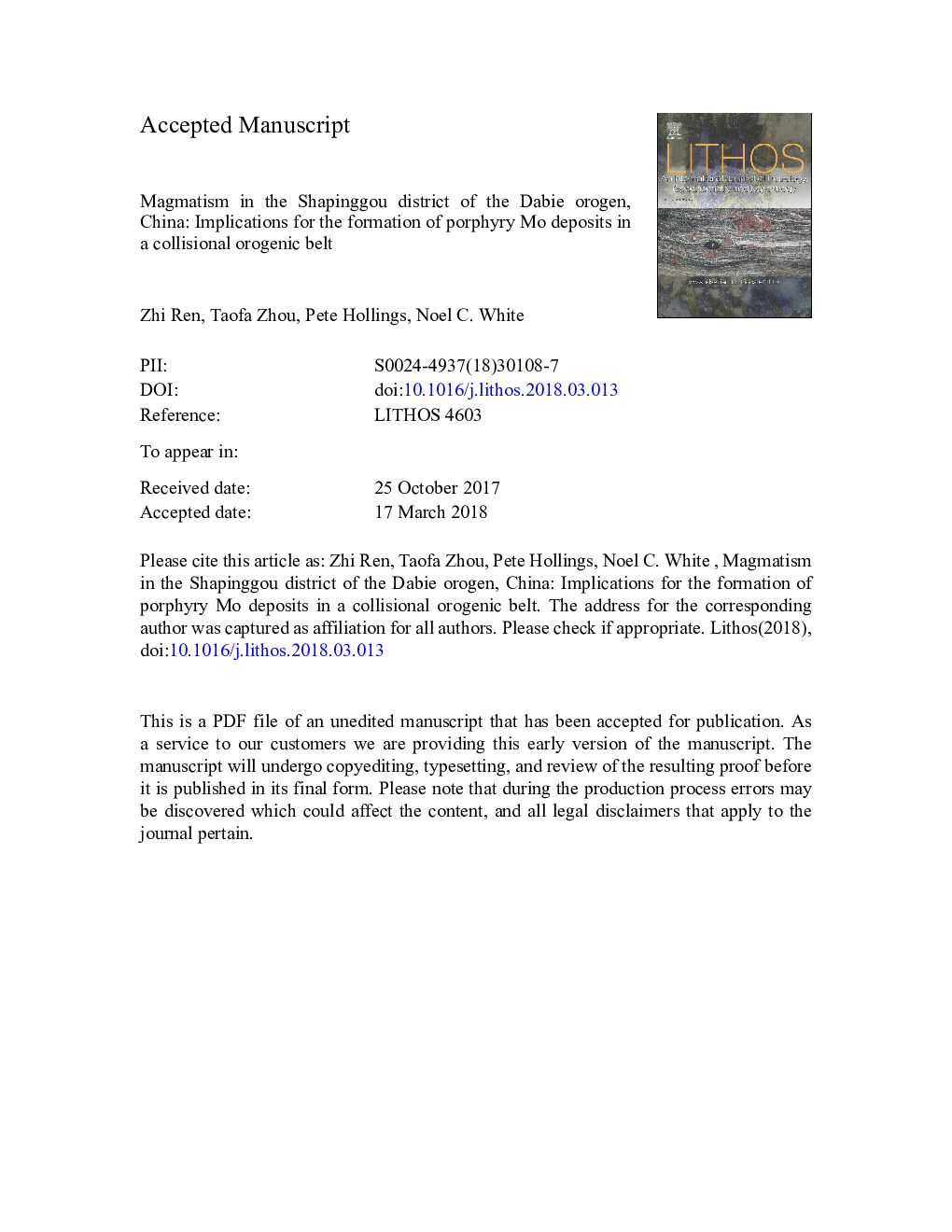| کد مقاله | کد نشریه | سال انتشار | مقاله انگلیسی | نسخه تمام متن |
|---|---|---|---|---|
| 8911657 | 1638620 | 2018 | 70 صفحه PDF | دانلود رایگان |
عنوان انگلیسی مقاله ISI
Magmatism in the Shapinggou district of the Dabie orogen, China: Implications for the formation of porphyry Mo deposits in a collisional orogenic belt
دانلود مقاله + سفارش ترجمه
دانلود مقاله ISI انگلیسی
رایگان برای ایرانیان
کلمات کلیدی
موضوعات مرتبط
مهندسی و علوم پایه
علوم زمین و سیارات
ژئوشیمی و پترولوژی
پیش نمایش صفحه اول مقاله

چکیده انگلیسی
The Shapinggou molybdenum deposit is located in the Qinling-Dabie Orogen, which hosts the world's largest molybdenum belt. The igneous rocks at Shapinggou can be divided into two stages (136-127â¯Ma and 118-114â¯Ma), the early suite of felsic (136-127â¯Ma, SiO2â¯=â¯58.0 to 72.9â¯wt%) and mafic rocks (133-128â¯Ma, SiO2â¯=â¯45.2 to 57.0â¯wt%), and a later suite comprising syenite (117â¯Ma, SiO2â¯=â¯64.2 to 65.0â¯wt%), quartz syenite porphyry (116â¯Ma, 62.5 to 70.0â¯wt%), granite porphyry (112â¯Ma, SiO2â¯=â¯75.5 to 77.6â¯wt%) and diorite porphyry (111â¯Ma, SiO2â¯=â¯56.6 to 59.7â¯wt%). The early-stage felsic rocks display high SiO2, Al2O3, Na2O, K2O, Sr, LREE contents, and Sr/Y, (La/Yb)N ratios, initial Sr isotope ratios of 0.7076 to 0.7089, but low MgO, FeOT, Y, Yb contents and negative εNd(t) values, consistent with partial melting of the lower continental crust. The early-stage mafic rocks exhibit low SiO2, high MgO, Ni and Cr contents, consistent with an upper mantle source, but trace element and isotope data suggest a role for crustal contamination. The late-stage syenite and quartz syenite porphyry show high abundances of Na2O, K2O, Al2O3, HFSEs (e.g., Th, U, Zr, Hf) and significant negative Eu anomalies. The late-stage granite porphyry displays high SiO2 contents, and depletions in Ba, Sr, Eu and Ti. The geochemical features of the late-stage intrusions are similar to A-type granites. Crystal fractionation of plagioclase, K-feldspar, biotite/ muscovite, amphibole/ garnet and Fe-Ti oxides controlled the evolution of the magma. The geochemical and isotopic data suggest that the rocks at Shapinggou were likely derived from a mixed source of lithospheric mantle, subducted continental crust of the Yangtze Block (Kongling Group) and partial melts of the Dabie Complex. Early stage rocks represent melts of the source with a lower proportion of Dabie Complex materials, whereas late stage rocks were derived from a source with a higher proportion Dabie Complex component. The geochemical and isotopic variations of the intrusions at Shapinggou were controlled by both source characteristics and fractional crystallization. Although the Shapinggou deposit is located in a continental collision orogen, the magmas formed in an intraplate extension setting, with an increase in the amount of extension from the early to late stages. As well, both stages intrusions at Shapinggou were generated by the addition of heat, due to lithospheric delamination, mantle upwelling and rapid mantle convection, related to the far-field effects of the westward subduction of the paleo-Pacific Plate beneath the Asian continent. The geochemistry and setting suggest that the formation of a giant Mo deposit does not require a Mo-rich magma source, but rather an efficient convection mechanism for the transport of volatiles and Mo in a granitic magma system. The fluids derived from the granite porphyry at Shapinggou were more oxidised than that from the barren intrusions.
ناشر
Database: Elsevier - ScienceDirect (ساینس دایرکت)
Journal: Lithos - Volumes 308â309, May 2018, Pages 346-363
Journal: Lithos - Volumes 308â309, May 2018, Pages 346-363
نویسندگان
Zhi Ren, Taofa Zhou, Pete Hollings, Noel C. White,